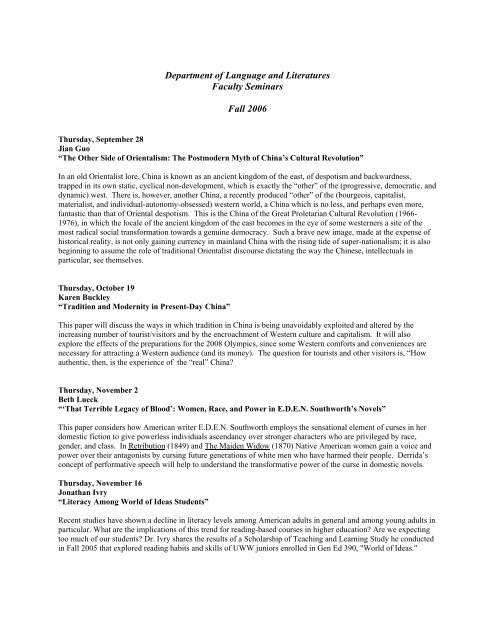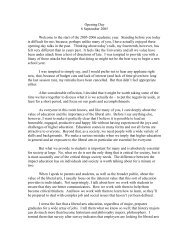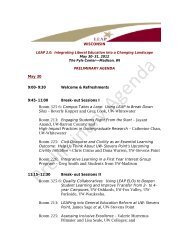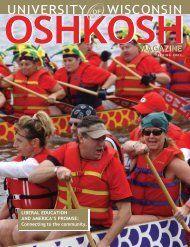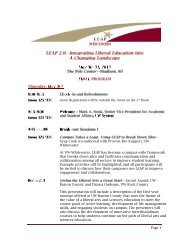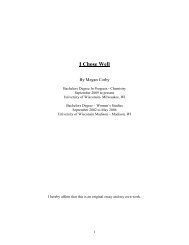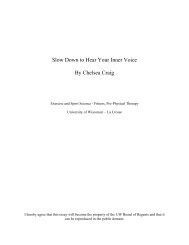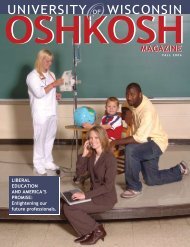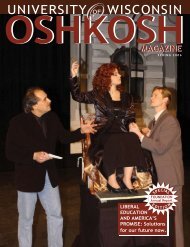whitewater_faculty_s.. - Liberal Education Initiative
whitewater_faculty_s.. - Liberal Education Initiative
whitewater_faculty_s.. - Liberal Education Initiative
You also want an ePaper? Increase the reach of your titles
YUMPU automatically turns print PDFs into web optimized ePapers that Google loves.
Department of Language and Literatures<br />
Faculty Seminars<br />
Fall 2006<br />
Thursday, September 28<br />
Jian Guo<br />
“The Other Side of Orientalism: The Postmodern Myth of China’s Cultural Revolution”<br />
In an old Orientalist lore, China is known as an ancient kingdom of the east, of despotism and backwardness,<br />
trapped in its own static, cyclical non-development, which is exactly the “other” of the (progressive, democratic, and<br />
dynamic) west. There is, however, another China, a recently produced “other” of the (bourgeois, capitalist,<br />
materialist, and individual-autonomy-obsessed) western world, a China which is no less, and perhaps even more,<br />
fantastic than that of Oriental despotism. This is the China of the Great Proletarian Cultural Revolution (1966-<br />
1976), in which the locale of the ancient kingdom of the east becomes in the eye of some westerners a site of the<br />
most radical social transformation towards a genuine democracy. Such a brave new image, made at the expense of<br />
historical reality, is not only gaining currency in mainland China with the rising tide of super-nationalism; it is also<br />
beginning to assume the role of traditional Orientalist discourse dictating the way the Chinese, intellectuals in<br />
particular, see themselves.<br />
Thursday, October 19<br />
Karen Buckley<br />
“Tradition and Modernity in Present-Day China”<br />
This paper will discuss the ways in which tradition in China is being unavoidably exploited and altered by the<br />
increasing number of tourist/visitors and by the encroachment of Western culture and capitalism. It will also<br />
explore the effects of the preparations for the 2008 Olympics, since some Western comforts and conveniences are<br />
necessary for attracting a Western audience (and its money). The question for tourists and other visitors is, “How<br />
authentic, then, is the experience of the “real” China<br />
Thursday, November 2<br />
Beth Lueck<br />
“‘That Terrible Legacy of Blood’: Women, Race, and Power in E.D.E.N. Southworth’s Novels”<br />
This paper considers how American writer E.D.E.N. Southworth employs the sensational element of curses in her<br />
domestic fiction to give powerless individuals ascendancy over stronger characters who are privileged by race,<br />
gender, and class. In Retribution (1849) and The Maiden Widow (1870) Native American women gain a voice and<br />
power over their antagonists by cursing future generations of white men who have harmed their people. Derrida’s<br />
concept of performative speech will help to understand the transformative power of the curse in domestic novels.<br />
Thursday, November 16<br />
Jonathan Ivry<br />
“Literacy Among World of Ideas Students”<br />
Recent studies have shown a decline in literacy levels among American adults in general and among young adults in<br />
particular. What are the implications of this trend for reading-based courses in higher education Are we expecting<br />
too much of our students Dr. Ivry shares the results of a Scholarship of Teaching and Learning Study he conducted<br />
in Fall 2005 that explored reading habits and skills of UWW juniors enrolled in Gen Ed 390, "World of Ideas."
Department of Language and Literatures<br />
Faculty Seminars<br />
Fall 2005<br />
Thursday, September 29<br />
Elena Levy-Navarro,<br />
Thin Privilege and the Fat Body in the Popular Rhetoric of the Obesity Epidemic<br />
In recent years, the rhetoric around the so-called obesity epidemic in America has been getting ever more shrill, in a<br />
way that can be explained by the scientific facts. Some physicians and medical researchers use purposefully<br />
inflammatory language, going so far as to liken their obesity epidemic to 9/11 or a silent tsunami. Such rhetoric<br />
serves to justify increased governmental intervention: state programs that mandate obesity programs in public<br />
schools, social services intervention to remedy the “neglect” of parents of obese children, and now proposed federal<br />
legislation that promotes a comprehensive war on obesity for the sake of long term “preventative heath care.” Why<br />
are so many institutions and people invested in the obesity epidemic What purpose does such rhetoric fulfill<br />
There are, of course, venal reasons: many that use such language have connections to the now five-billion dollar<br />
diet industry, but such reasons alone don’t explain the widespread social investment in this rhetoric.<br />
Thursday, October 13<br />
Jian Guo<br />
“Teaching the Story of the Fall: a Cross-Cultural Perspective”<br />
The story of the fall as related in the third chapter of the book of Genesis has both humanist import and experiential<br />
relevance. To develop this notion, I shall borrow the secular, psychological, and philosophical approach of<br />
Romanticism (Feuerback, Emerson, and Wordsworth) in my discussion of this story. And I shall also adopt a<br />
comparative perspective by juxtaposing the scriptural passage with part of the second chapter of the Tao Te Ching,<br />
demonstrating how they may shed light on each other while pointing more or less in the same direction regarding the<br />
coming into being of a discriminating consciousness (which signifies our departure from the blissful animal<br />
existence), especially in terms of perceived/constructed opposites and polarities. I shall embed this argument in a<br />
narrative about my teaching of the World of Ideas course.<br />
Tuesday, November 15<br />
Edie Thornton<br />
“From Gibson Girl to The X Files: Refashioning Lily Bart, 1905-2000" (slide lecture)<br />
The illustrations that accompanied the first appearance of Edith Wharton’s The House of Mirth in Scribner’s<br />
Magazine in January 1905 catapulted Wharton’s heroine, Lily Bart, into a thriving and expanding visual culture.<br />
Fueled by new technologies for mass printing and distribution, illustration was in its “Golden Age,” with artists<br />
commanding huge fees and attaining celebrity status in a culture suddenly bombarded with images and new visual<br />
stimulations. A significant aspect of this visual explosion was a group of illustrators who focused on creating the<br />
“look” of the American woman. These illustrators, including Harold Chandler Christy, Harrison Fisher, A.B.<br />
Wenzell, and others, created images of the “ideal woman” that were eagerly sought out by women readers who<br />
copied their clothing, hair, and, more significantly, their implied attitudes of what a “woman” should be. As a<br />
coda, this paper suggests that the recent film of The House of Mirth launched the visual coding of Lily Bart into yet<br />
another cult-like network of associations, this time with the hugely popular television series The X Files. Mirth a<br />
battleground over the fashioning -- and interpreting -- of Lily Bart.


